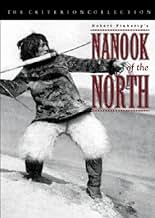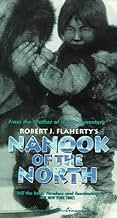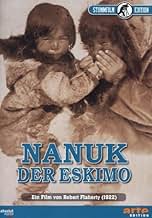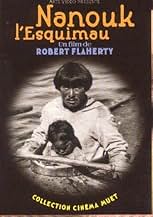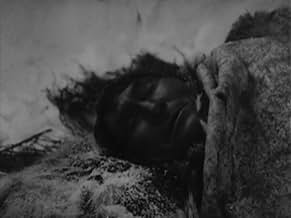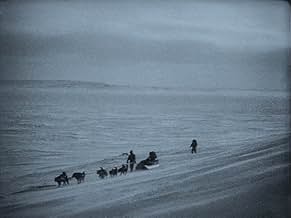VALUTAZIONE IMDb
7,6/10
14.079
LA TUA VALUTAZIONE
In questo predecessore muto del moderno documentario, il regista Robert J. Flaherty spende un anno seguendo le vite di Nanook e la sua famiglia, degli Inuit che vivono al Circolo Artico.In questo predecessore muto del moderno documentario, il regista Robert J. Flaherty spende un anno seguendo le vite di Nanook e la sua famiglia, degli Inuit che vivono al Circolo Artico.In questo predecessore muto del moderno documentario, il regista Robert J. Flaherty spende un anno seguendo le vite di Nanook e la sua famiglia, degli Inuit che vivono al Circolo Artico.
- Regia
- Sceneggiatura
- Star
- Premi
- 2 vittorie totali
Allakariallak
- Nanook
- (as Nanook)
Berry Kroeger
- Narrator (1939 re-release)
- (non citato nei titoli originali)
Recensioni in evidenza
Robert Flaherty is one of the more noted documentarians in the history of film. It is not without some concentration (ironically maybe) to watch his most well-known work, Nanook of North, which is as much documentary as it is almost the very first widely seen "Home movie". There's no narration aside from the several title cards listing the obvious things that Nanook and his family/tribe are doing in the arctic.
Therefore this is much more of a visual kind of documentary, not as outrageous and experimental as those of Dziga Vertov of the same period (using what camera equipment available, shooting seemingly on the fly), but with a distinct view on what life is usually like for these people. We basically see them doing very elementary tasks, more based on living day-to-day in this harsh climate than anything overly dramatized.
That all of the scenes are really 'staged' (and, apparently, it's not even Nanook's real wife) doesn't deter the viewer from what is being shown. It's like a mix of the objective and subjective- objective in the sense that 'this is what it is, the Eskimos hunting for food, raising their children, making their shelter in igloos, and making trips to ensure their survival'. Subjective in that Flaherty's camera is creating a specific view of these people, their faces captured memorably in the scratchy print of the film. In a way it's also like the first, and perhaps more groundbreaking, of the lot of nature documentaries to follow over the years, though to a primitive extreme.
In all, Nanook of the North is meant to above all show the versatility of these people, both the physical nature (i.e. hunting the seal, which is the most exciting in the film) and the nature of the spirit of these people, living this way as a cycle over and over again.
Therefore this is much more of a visual kind of documentary, not as outrageous and experimental as those of Dziga Vertov of the same period (using what camera equipment available, shooting seemingly on the fly), but with a distinct view on what life is usually like for these people. We basically see them doing very elementary tasks, more based on living day-to-day in this harsh climate than anything overly dramatized.
That all of the scenes are really 'staged' (and, apparently, it's not even Nanook's real wife) doesn't deter the viewer from what is being shown. It's like a mix of the objective and subjective- objective in the sense that 'this is what it is, the Eskimos hunting for food, raising their children, making their shelter in igloos, and making trips to ensure their survival'. Subjective in that Flaherty's camera is creating a specific view of these people, their faces captured memorably in the scratchy print of the film. In a way it's also like the first, and perhaps more groundbreaking, of the lot of nature documentaries to follow over the years, though to a primitive extreme.
In all, Nanook of the North is meant to above all show the versatility of these people, both the physical nature (i.e. hunting the seal, which is the most exciting in the film) and the nature of the spirit of these people, living this way as a cycle over and over again.
Thoroughly Modern Flaherty
by: Christopher M. McHugh
Robert Flaherty's second film on Eskimos, "Nanook of the North," is one of the world's first examples of a cinema verite' / aesthetic expressionism documentary. His first film outing into the Eastern Hudson Bay is now lost (allmovie.com), "Nanook of the North" was his second attempt. To deal with the extreme cold Flaherty utilized two recently developed Akeley gyroscope cameras that required little lubrication so that he could tilt and pan (cinemaweb.com). Flaherty clearly had a special place in his heart for the Itivimuit people. At times his documentary resembles a home movie, concentrating on Nanook's family's personality, rather than simply the actions they take part in. He does this primarily through the use of close-ups and filming private moments; such as the family waking up. The audience finds themselves smiling back at young Allegoo as he drinks castor oil. In regards to the soundtrack for "Nanook," the VHS copy I viewed didn't seem to match up with the visuals. When Nanook and his family are going to bed, the music is so intense it seams like the family should be fighting a bear, rather than nodding off for the night. Perhaps this problem has been remedied in the Criterion Collection's edition, which was released in 1999 on DVD (FYI available at half.com). The title cards in "Nanook" display, once again Flaherty's fondness for his subject material. Not only, Nanook's family, but Flaherty also seems to display a fondness for the Hudson Bay landscape. Flaherty does this through utilizing flowery language. For example, when we see a shot of the horizon, Flaherty's card reads: "the sun mocks them during the long winter (paraphrasing)." The lighting is excellent in "Nanook," due mostly in part to the fact that Flaherty staged sequences that couldn't be lit properly, such as building a bigger (mock) igloo to accommodate his cameras and lights. It is unclear whether these shots were filmed closer to civilization, due to Flaherty's use of the Haulberg Electric Light Plant (Flaherty 1922)and its need for fuel. Flaherty attempts to make Nanook's family a symbol for the typical, 1920's U.S. family, as (a typical U.S. family) might have lived if they were in Nanook's family's snowshoes. Flaherty even goes so far as to exclude Nanook's second wife, Cunayou (CultureDose.com) [YAY! EXTRA CREDIT!] with the exception of one particularly noticeable shot where the family is getting out of bed. Flaherty treated Nanook's family as though it might have been his own. He even went so far as to show the family dailies so that they could give him input. Flaherty pointed out in his paper, "How I filmed Nanook of the North," that he shared much with the Itivimuit, including his gramophone, tea, tobacco and sea biscuits. The Itivimuit responded back by helping out Flaherty as much as possible, leaving extra food for him and by making sure he was safe (Flaherty 1922).
As far a cinematography goes "Nanook" holds up quite well. As stated earlier, Flaherty was able to pull off pans and tilts, even in such a cold environment. The shots are framed quite well, since most of the time Flaherty didn't need to rip his equipment out in a moments notice. Nanook himself, for the most part, seemed to indicate what was going to be happening every step of the way (before it actually happened).
The pacing of "Nanook" seems to flow like rolling hills. After much action takes place Flaherty gently takes us down and puts us to bed with the family. While such action as the seal hunt is built up with quite a bit of anticipation. And when Nanook and his comrades struggle with the seal (for 20 minutes in reality), the audience is left biting their nails.
Upon viewing "Nanook" for a second time I realized how little has changed in U.S. society, as to their perceptions of those who live in a non-material world (and continue to hunt for food themselves). A 20-hundreds audience's initial reaction is probably very similar to that of a 19-twenties audience. This initial reaction subsides once Flaherty draws us into Nanook's family and they become human to us. I imagine some might criticize Flaherty for his shots of Nanook and his family members posing and smiling straight on at the camera, but these moments are most precious in "Nanook of the North." From what I gather from various sources and his paper, Mr. Flaherty was out in this frozen wilderness with no other English-speaking individuals. He obviously had a command of the language or a translator, but even more than that he obviously treated his subjects with dignity (on and off camera). His style here is closer to participant observation, rather than an ethnography. A good lesson can be learned from Flaherty, in that, great friendship and even some fun can be had when the filmmaker surrounds himself with his subject, although she or he may loose their objectivity. However, to be closer to a people is to understand them better. No one can doubt that Flaherty's take on the travel film is ingenious and that he revolutionized the film industry. To this day, "Nanook of the North" succeeds in being a modern film, easily accessible to anyone. It conveys the lifestyle and ideas of a different culture clearly and with a very human touch. And that is all that anyone could want from a documentary.
by: Christopher M. McHugh
Robert Flaherty's second film on Eskimos, "Nanook of the North," is one of the world's first examples of a cinema verite' / aesthetic expressionism documentary. His first film outing into the Eastern Hudson Bay is now lost (allmovie.com), "Nanook of the North" was his second attempt. To deal with the extreme cold Flaherty utilized two recently developed Akeley gyroscope cameras that required little lubrication so that he could tilt and pan (cinemaweb.com). Flaherty clearly had a special place in his heart for the Itivimuit people. At times his documentary resembles a home movie, concentrating on Nanook's family's personality, rather than simply the actions they take part in. He does this primarily through the use of close-ups and filming private moments; such as the family waking up. The audience finds themselves smiling back at young Allegoo as he drinks castor oil. In regards to the soundtrack for "Nanook," the VHS copy I viewed didn't seem to match up with the visuals. When Nanook and his family are going to bed, the music is so intense it seams like the family should be fighting a bear, rather than nodding off for the night. Perhaps this problem has been remedied in the Criterion Collection's edition, which was released in 1999 on DVD (FYI available at half.com). The title cards in "Nanook" display, once again Flaherty's fondness for his subject material. Not only, Nanook's family, but Flaherty also seems to display a fondness for the Hudson Bay landscape. Flaherty does this through utilizing flowery language. For example, when we see a shot of the horizon, Flaherty's card reads: "the sun mocks them during the long winter (paraphrasing)." The lighting is excellent in "Nanook," due mostly in part to the fact that Flaherty staged sequences that couldn't be lit properly, such as building a bigger (mock) igloo to accommodate his cameras and lights. It is unclear whether these shots were filmed closer to civilization, due to Flaherty's use of the Haulberg Electric Light Plant (Flaherty 1922)and its need for fuel. Flaherty attempts to make Nanook's family a symbol for the typical, 1920's U.S. family, as (a typical U.S. family) might have lived if they were in Nanook's family's snowshoes. Flaherty even goes so far as to exclude Nanook's second wife, Cunayou (CultureDose.com) [YAY! EXTRA CREDIT!] with the exception of one particularly noticeable shot where the family is getting out of bed. Flaherty treated Nanook's family as though it might have been his own. He even went so far as to show the family dailies so that they could give him input. Flaherty pointed out in his paper, "How I filmed Nanook of the North," that he shared much with the Itivimuit, including his gramophone, tea, tobacco and sea biscuits. The Itivimuit responded back by helping out Flaherty as much as possible, leaving extra food for him and by making sure he was safe (Flaherty 1922).
As far a cinematography goes "Nanook" holds up quite well. As stated earlier, Flaherty was able to pull off pans and tilts, even in such a cold environment. The shots are framed quite well, since most of the time Flaherty didn't need to rip his equipment out in a moments notice. Nanook himself, for the most part, seemed to indicate what was going to be happening every step of the way (before it actually happened).
The pacing of "Nanook" seems to flow like rolling hills. After much action takes place Flaherty gently takes us down and puts us to bed with the family. While such action as the seal hunt is built up with quite a bit of anticipation. And when Nanook and his comrades struggle with the seal (for 20 minutes in reality), the audience is left biting their nails.
Upon viewing "Nanook" for a second time I realized how little has changed in U.S. society, as to their perceptions of those who live in a non-material world (and continue to hunt for food themselves). A 20-hundreds audience's initial reaction is probably very similar to that of a 19-twenties audience. This initial reaction subsides once Flaherty draws us into Nanook's family and they become human to us. I imagine some might criticize Flaherty for his shots of Nanook and his family members posing and smiling straight on at the camera, but these moments are most precious in "Nanook of the North." From what I gather from various sources and his paper, Mr. Flaherty was out in this frozen wilderness with no other English-speaking individuals. He obviously had a command of the language or a translator, but even more than that he obviously treated his subjects with dignity (on and off camera). His style here is closer to participant observation, rather than an ethnography. A good lesson can be learned from Flaherty, in that, great friendship and even some fun can be had when the filmmaker surrounds himself with his subject, although she or he may loose their objectivity. However, to be closer to a people is to understand them better. No one can doubt that Flaherty's take on the travel film is ingenious and that he revolutionized the film industry. To this day, "Nanook of the North" succeeds in being a modern film, easily accessible to anyone. It conveys the lifestyle and ideas of a different culture clearly and with a very human touch. And that is all that anyone could want from a documentary.
Explorer Robert J. Flaherty spent the majority of 1914 and 1915 along the Hudson Bay, doing research and exploring for a Canadian railway company. Being a keen photographer and potential film-maker, he took a camera along with him. He shot 30,000 feet of film, of the native Eskimo tribes and their alien, hunter-gatherer lifestyle. The test footage was met with universal excitement, only Flaherty dropped a cigarette on the highly-flammable nitrate film-stock whilst editing, and lost it all. He would return, only this time with the sole intent on making a narrative- driven documentary, about one specific family of Eskimos, and their highly-charismatic leader Nanook, a legendary hunter.
Though it is now widely heralded as a masterpiece, and the film that gave birth to the documentary genre, the film is often criticised for its obviously staged dramatic scenes, and truth-manipulation in the search for a coherent narrative and to inject the film with an air of excitement and wonder. Personally, I have no problem with this approach, after all, one of my favourite directors Werner Herzog frequently does this in his documentary films to create a sort of artistic truth, opposed to the point-the-camera approach of cinema verite. In the modern age, we are treated to high-definition, sweeping footage of some of the most exotic and hostile corners of the planet, so it's a marvel to see where it all started, and Flaherty, faced with early, clunky film equipment and relatively little experience of film-making, created a magical documentary for an audience that, back then, knew little about the world outside their own country.
Amongst the many set-pieces we are treated to, the greatest (and much- celebrated) is the building of the igloo. We watch Nanook build it with skilled precision, slab by slab, and even incorporate a window feature, in order to give the igloo some warmth, and a chunk of ice by the side of it to divert the sun's rays. With many Eskimos now adopting Western aspects into their livelihood, the film is definitely a window into the past (the Eskimos had in fact already done this, and even wore Western clothes, but Flaherty persuaded them to revert back in order to give the film more of a sense of wonder). For a film-maker who had only taken a three-week course in cinematography prior to Nanook, the film is rich with beautiful imagery. The scene that watches the family trudge into the distance as the mist blows over the snowy surface like fleeing ghosts, gives the film a gorgeous, eerie quality. If you can forgive the film's manipulations, then this is still one of the greatest documentaries features ever produced, and Nanook (real name Allakariallak) proves to be a charming protagonist.
www.the-wrath-of-blog.blogspot.com
Though it is now widely heralded as a masterpiece, and the film that gave birth to the documentary genre, the film is often criticised for its obviously staged dramatic scenes, and truth-manipulation in the search for a coherent narrative and to inject the film with an air of excitement and wonder. Personally, I have no problem with this approach, after all, one of my favourite directors Werner Herzog frequently does this in his documentary films to create a sort of artistic truth, opposed to the point-the-camera approach of cinema verite. In the modern age, we are treated to high-definition, sweeping footage of some of the most exotic and hostile corners of the planet, so it's a marvel to see where it all started, and Flaherty, faced with early, clunky film equipment and relatively little experience of film-making, created a magical documentary for an audience that, back then, knew little about the world outside their own country.
Amongst the many set-pieces we are treated to, the greatest (and much- celebrated) is the building of the igloo. We watch Nanook build it with skilled precision, slab by slab, and even incorporate a window feature, in order to give the igloo some warmth, and a chunk of ice by the side of it to divert the sun's rays. With many Eskimos now adopting Western aspects into their livelihood, the film is definitely a window into the past (the Eskimos had in fact already done this, and even wore Western clothes, but Flaherty persuaded them to revert back in order to give the film more of a sense of wonder). For a film-maker who had only taken a three-week course in cinematography prior to Nanook, the film is rich with beautiful imagery. The scene that watches the family trudge into the distance as the mist blows over the snowy surface like fleeing ghosts, gives the film a gorgeous, eerie quality. If you can forgive the film's manipulations, then this is still one of the greatest documentaries features ever produced, and Nanook (real name Allakariallak) proves to be a charming protagonist.
www.the-wrath-of-blog.blogspot.com
Nanook of the North was a delight to watch from start to finish. What is captured on film is a priceless glimpse into an Eskimo family's life from the early days of film-making. Some people consider the film to be pejorative; particularly in the portrayal of Nanook as simple-minded enough to think little people live inside a phonograph speaker; or in the next frame where he is portrayed confusing a phonograph record with something to eat. I was not offended by this; conversely, considering when the film was made these scenes were endearing to me. Ultimately, what I like best about this film are the close-ups of Nanook and his family, particularly his children. The emotions expressed on their faces when they are happy and playful or sad and afraid reveal the universal link we all share as humans. It is a link that transcends the vast spaces of both cultural distance and time. The film is a masterpiece!
Robert J. Flaherty's `Nanook Of The North' may be the first film about man's relationship with nature. Flaherty helps establish man's successful adaptation to his environment by filming extraordinary hunting and fishing scenes consisting largely of medium shots. The few close-ups of the Inuit generally portray the successful hunters smiling as they eat their kill. Flaherty contrasts these moments with sequences communicating the Inuit's struggles with the natural world. Here, he uses long shots: Nanook and his family become tiny black specks barely visible in the large, white frame. In the foreground the viewer sees bitter gusts of wind ruling over the desolate landscape. Flaherty's technique is simple but very effective. Not only does he depict man as a mere part of his environment, but he emphasizes how powerless man may feel amid the cold indifference of nature. At the same time, the hunting and feast sequences establish Nanook as a smart, tough survivor, a surprising victor over nature's harsh elements. In this way, Flaherty makes Nanook into a heroic figure.
Rating: 9.5
Rating: 9.5
Lo sapevi?
- QuizThe claim that Allakariallak died of starvation in 1922, months after the film was completed, is untrue; he did not starve but likely succumbed to tuberculosis.
- Citazioni
Title Card: The shrill piping of the wind, the rasp and hiss of driving snow, the mournful wolf howls of Nanook's master dog typify the melancholy spirit of the North.
- Curiosità sui creditiA story of life and love in the actual arctic.
- Versioni alternativeRemastered with image enhancement, speed correction and a new score in 1998
- ConnessioniEdited into Saumialuk. Le grand gaucher (1990)
I più visti
Accedi per valutare e creare un elenco di titoli salvati per ottenere consigli personalizzati
- How long is Nanook of the North?Powered by Alexa
Dettagli
Botteghino
- Budget
- 53.000 USD (previsto)
- Tempo di esecuzione
- 1h 18min(78 min)
- Mix di suoni
- Proporzioni
- 1.33 : 1
Contribuisci a questa pagina
Suggerisci una modifica o aggiungi i contenuti mancanti


